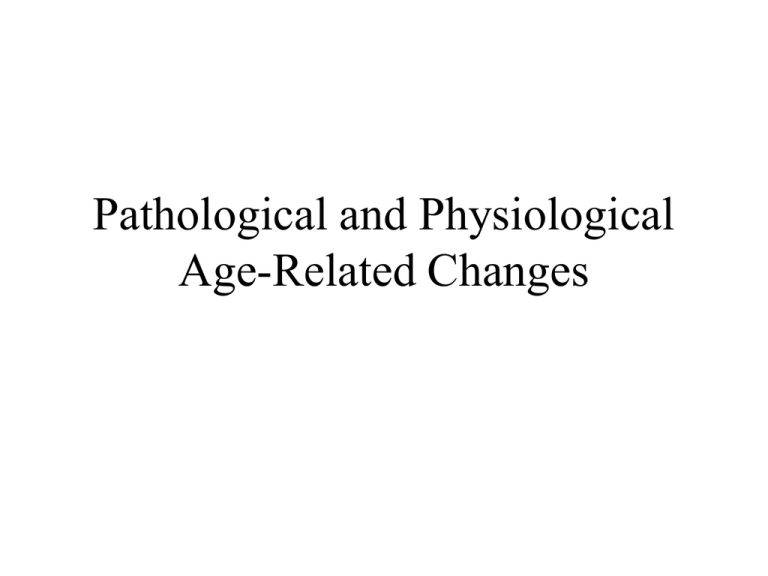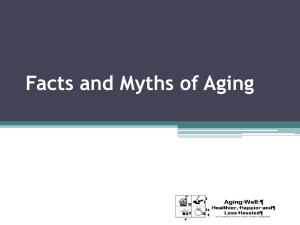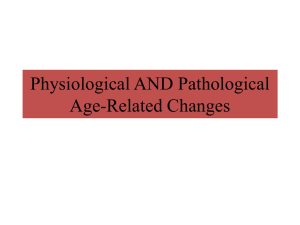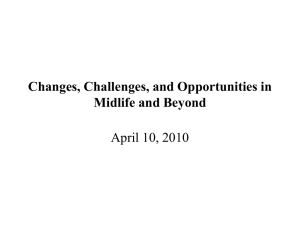RHPT 483
advertisement

Pathological and Physiological Age-Related Changes INTRODUCTION Human aging is associated with a wide range of physiological changes that limit our normal functions render us more susceptible to a number of diseases make us more susceptible to death Aging is characterized by changes in appearance, such as gradual reduction in height and weight loss due to loss of muscle and bone mass, a lower metabolic rate, longer reaction times, declines in certain memory functions, declines in sexual activity--and menopause in women--, a functional decline in audition, olfaction, and vision, declines in kidney, pulmonary, and immune functions, declines in exercise performance, and multiple endocrine changes • The incidence of a number of pathologies increases with age. These include type 2 diabetes, heart disease, cancer, arthritis, and kidney disease. Prevalence of selected chronic conditions, expressed in percentages, as a function of age for the US population (2002-2003 dataset). All forms of cancer and heart disease are featured. Source:National Center for Health Statistics, Data Warehouse on Trends in Health and Aging. What are the most common physiological changes caused by aging? The most common physiological changes with aging; starting from the top of your head, is getting gray and loss of hair. In your eye, the amount of light coming in your eye decreases, so it's harder to detect colours and you may need reading glasses. With your nose, you can have problems with smell. Concerning your ears, you have decreased hearing. With taste, you lose your taste ability with aging. Your joints become stiffer. your skin changes and becomes less flexible. Your heart can't beat as rapidly and your lungs don't expand and contract as efficiently. Your kidneys don't secrete urine ETC… Changes in the cardio-vascular system: • There is normal atrophy of the heart muscle, especially in the left ventricle, calcification of the heart valves, loss of elasticity in artery walls (arteriosclerosis) and intra-artery deposits (atherosclerosis). Changes in the cardio-vascular system: • There is decreased cardiac output, baroreceptor sensitivity and SA node automaticity. • The reduced blood flow results in reduced stamina, reduced renal and hepatic function and less cellular nourishment. • There is impaired blood pressure response to standing,volume depletion and heart blocks Changes in the respiratory system: • The airways and lung tissue become less elastic with reduced cilia activity. • The diaphragm and intercostal muscles become weaker. • There is decreased oxygen uptake and exchange. • The chest is less able to stretch to breathe, and the pattern of breathing may change slightly to compensate for this decreased ability to expand the chest. • There is ventilation/perfusion mismatch and decreased PO2. This leads to decreased stamina with shortness of breath and fatigue • Maximum lung function decreases with age. • The amount of oxygen diffusing from the air sacs into the blood decreases. • The rate of air flow through the airways slowly declines after age 30. And the maximal force you can generate on inspiration and expiration decreases. • An important change for many older people is that the airways close more readily. The airways tend to collapse when an older person breathes shallowly or when they're in bed for a prolonged time. COMMON ELDERLY PROBLEMS – DUE TO CHANGES IN RESPIRATORY SYSTEM • Elderly people are at increased risk for lung infections. • The cough reflex may not trigger as readily, and the cough may be less forceful. • The hair like projections that line the airway (cilia) are less able to move mucus up and out of the airway. • In addition, the nose and breathing passages secrete less of a substance called IgA (an antibody that protects against viruses). • Thus, the elderly are more susceptible to pneumonia and other types of lung infections. Changes in musculo-skeletal system: • There is generalized atrophy of all muscles accompanied by a replacement of some muscle tissue by fat deposits. • This results in some loss of muscle tone and strength. • Calcium is lost and bones become less dense. This can result in osteoporosis and a reduction of weight bearing capacity, leading to the possibility of Spontaneous fracture. • Thinning of the vertebrae also results in a reduction in height. In addition, the vertebrae can calcify, resulting in postural changes. • The joints also undergo changes. In fact, arthritis, the degenerative inflammation of the joints, is the most common chronic condition in the elderly Changes in skin The skin loses underlying fat layers and oil glands, causing wrinkles and reduced elasticity. There is increased susceptibility to cold, bruising and bedsores. In addition, the skin develops “age spots” due to deposits of melanin pigment. The hair gradually loses its pigmentation and turns gray. The nails become thicker due to reduced blood flow to the connective tissues. The skin becomes somewhat less sensitive to sensations including heat, cold and injury Changes in the gastrointestinal system: • There is reduction in the production of hydrochloric acid, digestive enzymes and saliva. • These changes may result in gastrointestinal distress, impaired swallowing and delayed emptying of the stomach. • The breakdown and absorption of foods may also be impaired, sometimes resulting in deficiencies of vitamin B, C, and K or in extreme cases, malnutrition GI Changes in the metabolic system • The metabolic system is responsible for changing food into energy. • After age 25, everyone experiences approximately a 1%decrease per year in their metabolic rate. • This overall slowing results in food being less well absorbed and utilized. • There is a decrease in the overall metabolism of drugs Changes in sexuality • Sexual desire and performance may continue well into an individual’s eighth and ninth decade although frequency may diminish. • Physiological changes in women include atrophy of the ovarian, vaginal and uterine tissues with decreased production of vaginal fluids. • In men, sperm production is decreased and prostate enlarges. • Both older men and women generally require more stimulation to become aroused and more time to reach orgasm Sensory changes with aging: i. Changes in vision: Our special senses play a central role in our ability to gather information and to participate in social interactions. In the fourth decade, the pupil begins to decrease in size and there is decreased response to light. Because of these changes, older people require three times the amount of illumination to see as compared to a younger person. Focusing takes longer with an increase in nearsightedness, making small print harder to read. There is thickening and yellowing of the lens of the eye. This results in light diffraction, increased sensitivity to glare, decreased depth perception and more difficulty distinguishing pastel colors, especially blues and greens ii. Changes in hearing: • There is a decrease in sensitivity to high frequency tones and decreased discrimination of similar pitches because of changes in the bones and cochlear hair cells of the inner ear. • Approximately 30% of all elderly persons have some hearing impairment. iii. Changes in taste and smell: • Taste and smell are interrelated and important for eating as well as checking for hazards in the environment such as spoiled food, smoke and fumes. • Older adults experience some decline in the ability to taste resulting from a reduction in the total number of taste buds, especially after the age of 80. • Some individuals also experience a decline in their sense of smell, but this is usually because of abnormal conditions such as blockage or disease of the olfactory receptors in the upper sinus Cognitive changes associated with aging: • After age 25, everyone loses nerve cells. Gradually over time, this results in a reduced efficiency of nerve transmission which affect response time and coordination. • These changes may also affect sleeping patterns by decreasing the length of total sleep time and REM sleep . • In spite of these anatomical and physiological changes in brain, studies have found evidence of limited impairment of actual intellectual functioning associated with the aging process. • Intellectual ability is one the factors affecting functioning in later life. The various changes in cognition are: i. Effect on intelligence: • Intelligence generally is associated with a range of abilities that allow us to make sense of our experiences: the ability to comprehend new information, the ability to think abstractly, the ability to make rational decisions, spatial ability, numerical ability, verbal fluency, etc. Some abilities (e.g., the ability to think abstractly) are biologically determined and are known as “fluid intelligence.” • Other intellectual abilities (e.g., verbal fluency) reflect the knowledge and skills a person has gained through life experience and known as “crystallized intelligence.” • Intelligence tests have demonstrated a pattern of age-related changes in intellectual functioning. These tests show somewhat poorer performance by older people on tests of fluid intelligence, but little or no difference on tests of crystallized intelligence. • The fact that older persons perform more poorly on tests of fluid intelligence is due in part to reduced efficiency of nerve transmission in the brain, resulting in slower information processing and greater loss of information during transmission. • Other factors affecting cognitive performance are only indirectly related to the aging process itself. ii. Effect on learning and memory: • Most persons experience a modest increase in memory problems as they get older, particularly with regard to the ability to remember relatively recent experiences. There is impairment of the ability to accumulate new information and to retrieve existing information from memory. • There is little decline in the ability to store new information once it is learned Personality changes associated with aging: • Whereas basic personality traits may remain rather stable throughout adulthood, relatively predictable shifts may occur in other aspects of a person’s personality. • One of the best documented personality changes in adulthood is an increased preoccupation with one’s inner life, including greater attention to personal feelings and experiences and reduced extraversion. • A second domain in which age-related changes have been reported is gender role identity. • With advancing age, men and women appear to become more similar in terms of their values and personality styles. • Studies in a number of different cultures have found that men tend to become more nurturing, expressive and affiliation-seeking as they grow older, whereas women tend to become more instrumental and achievement-oriented Delaying the Effects of Aging • The process of aging may be inevitable, however one may potentially delay the effects and severity of this progression. While there is no consensus of efficacy, the following are reported as delaying cognitive decline: • High level of education • Physical exercise • Staying intellectually engaged i.e. Reading and mental activities (such as crossword puzzles) • Maintaining social and friendship networks • Maintaining a healthy diet, including omega-3 fatty acids, and protective antioxidants. SUMMARY • To sum it up, aging is a complex process composed of several features: 1) an exponential increase in mortality with age; 2) physiological changes that typically lead to a functional decline with age; 3) increased susceptibility to certain diseases with age.




